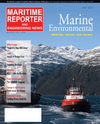
Page 15: of Maritime Reporter Magazine (July 2011)
The Green Ship Edition
Read this page in Pdf, Flash or Html5 edition of July 2011 Maritime Reporter Magazine
Businesses need to have contingency plans for getting the manpower they need.Assessing responsibilities to others.A marina may have pledged to haul ves- sels out of the water if a hurricane is ap- proaching. A barge may be contractually obligated to deliver goods before a dead- line, without regard to weather-related events, such as a flood-stage river that is no longer navigable. These types of con- tracts should be reviewed carefully and modified if necessary to protect a busi- ness from being committed to performservices that may not be achievable. I PP TH TTH After a disaster, commerce grinds to a halt locally, and the flow of income is in- terrupted as businesses lose the ability to operate and customers find alternatives. The long-term effect can be substantial. The American Red Cross estimates that 0 percent of small businesses never re- open after a disaster. But here too, plan- ning can make a difference. A business continuity plan that is spe- cific to a company?s situation can address a number of factors so the response to a disaster is well organized and almost au- tomatic. Elements of such a plan can in-clude: an alternative worksite, an employee notification process, appoint- ing a logistics lead for continuing opera- tions, and a communication plan forcustomers, suppliers and others.While such plans can range from rela-tively simple to very extensive, many re- sources and templates exist to help companies prepare. ften an insurer?s risk control services will include assess-ing business continuity plans and provid- ing assistance in identifying strengths andweaknesses. Insurance agents can also behelpful in working with businesses to an- nually review plans so they are properly updated with current information. aving business interruption or loss of income coverage as part of a company?s insurance can also be a critical compo-nent of the plan, especially if it is with thesame insurer that provides the property coverage. aving a single insurer can streamline the claim process and allow a business to better focus on getting back to business. II T TH STS Contingency plans can make the differ- ence between whether a business survives or sinks after a natural disaster strikes. nfortunately, many businesses simply overlook the planning process, believing that their insurance alone is enough. The fact of the matter is proper risk manage- ment and preparing to survive demand both. By working with agents and carri- ers, marine business owners can put solid pre- and post-disaster plans in place, andstand a much better chance of riding outthe storms that may be headed our way. July 2011www.marinelink.com 15CCTI In the May 2011 column Todays Ports ? Tomorrows Pres- sures, we inaccurately cited a statistic. We apologize for this error and share the correct statistic as follows ? According to the World Factbook, in 2010 in the nited tates received nearly 2 trillion in imports, taking the number one posi- tion among all countries, and shipped out close to 1.3 trillion in exports, third behind China and Germany.

 14
14

 16
16
